The main living environments of animals are water, land-air and soil. Each of them is inhabited by various animals.
Ground-air environment. It was mastered by spiders, insects, reptiles, birds, animals (Fig. 7. A). Here there are animals running fast across open spaces (steppes, meadows, deserts); living in the forest and climbing the branches of trees and shrubs; living under the forest canopy.
Rice. 7. Animals of different habitats: A - ground-air; B - water; B - soil; G - living in others and on other animals
According to the habitat conditions, the ground-air environment is the most diverse. Therefore, the animals that have mastered it are distinguished by their diversity, complex structure and behavior.
Aquatic habitat. The living conditions of animals in it are very different from the conditions of the ground-air environment. The density of water is almost 1000 times greater than the density of air. In water, there are stronger pressure drops, less oxygen, more active than in air, the absorption of sunlight occurs. Fish, whales, dolphins, crayfish, mollusks, insects, etc. live in the aquatic environment (Fig. 7, B). Some animals “hover” in the water column (plankton), others swim quickly (nekton), some stay at the bottom (benthos) or at the very surface of the reservoir.
Soil as a living environment. The soil has a very dense structure, light does not penetrate into it. Here, temperature differences are smoothed out, a special regime of humidity is created. Together with representatives of other kingdoms of organisms, animals such as earthworms, ticks, insect larvae, ants, and bears live in the soil (Fig. 7. B). Many animals dig holes in the soil, and the mole and the mole rat spend their whole lives underground.
Some animals have mastered not one, but two environments at once. So, frogs live both in ground-air and in aquatic environments, ground squirrels and field mice live in ground-air and in soil.
Animal habitats. In any environment, animals do not completely populate it, but occupy the most favorable areas for them. They are called animal habitats (Fig. 8).
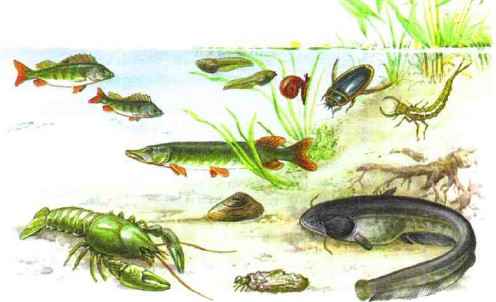
Rice. 8. Animals of different habitats in the aquatic environment
Nightingales are found only in damp, dark areas of the forest near ponds and edges. Pike living in rivers prefer places with a slow current and aquatic plants near the banks (whirlpools and backwaters).
Large mobile animals have large and spacious habitats. For example, whales and dolphins live in the seas and oceans. Nimble moving tits live in mixed forests, oak forests and coniferous groves. Small animals occupy small habitats. So, aphids live on green leaves and young shoots of plants. Often the same habitat is inhabited by different species of animals. Habitats that occupy vast areas, such as seas, forests, steppes, are inhabited by the largest number of animal species.
Animals are well adapted to life in certain habitats. Steppe animals have long legs, which contribute to fast running and big jumps. Tree-climbing animals have sharp claws or suckers, while aquatic animals have fins or swimming membranes between the fingers. Many animals successfully hide from enemies due to their protective coloration and camouflaging body shape.
Relationships of animals in nature
The relationship of animals, when some prey on others, kill and feed on them, is called predation.
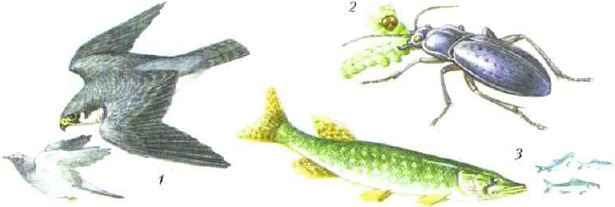
Rice. 9. Predators and victims: 1 - falcon and dove; 2 - beetle and caterpillar; 3 - pike and roach
Predators are a falcon chasing a dove; a beetle attacking a caterpillar; pike, which catches and eats roach (Fig. 9). Animals that are preyed upon by predators. - their victims. Predators have adaptations for hunting - these are the spider's trapping web, the powerful teeth of wolves and tigers. sharp claws of owls. The victims have adaptations to hide, to run away from the predator, to protect themselves from it. These are fast legs of an antelope, large ears of a hare, protective coloration of a chameleon, needles of a hedgehog, echidnas.
Animals inhabiting the same habitat or eating similar food enter into competitive relations.
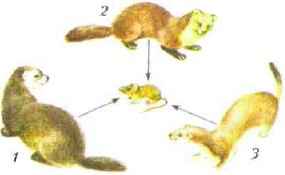
Rice. 10. Competitors in hunting for a mouse: 1 - black ferret: 2 - weasel; 3 - ermine
In a state of competition are, for example, from animals - stoats and ferrets that feed on mice and voles (Fig. 10); of birds - flycatchers and tits, competing with each other for shelters (hollows) suitable for nesting. Each of a pair of competing species is at a disadvantage. There are also mutually beneficial relationships between animals - symbiosis (you met him when studying plants) (Fig. 11). So, a hermit crab specially transplants sea anemones onto its shell.
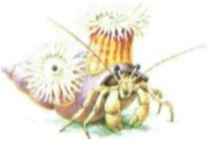
Rice. 11. Symbiosis: hermit crab and sea anemone
She protects him with burning tentacles from the attack of enemies, and a hermit crab. moving, allows the sedentary sea anemone to change places of hunting and catch more prey. Among animals there are also such relations which are useful for one animal and harmless for another. Such relationships are called lodging. For example, various insects, toads, lizards can settle in a marmot hole (Fig. 12). They bring no harm or benefit to the groundhog, and the groundhog provides them with its refuge.
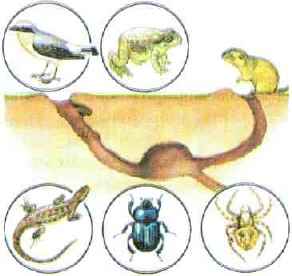
Rice. 12. Tenants: groundhog hole with lodgers
Place and role of animals in natural communities
Animals depend on each other and contact not only with each other, but also with plants and other living organisms: bacteria, fungi.
Living organisms living together form biological communities, or biocenoses. Biocenosis is a collection of animals, plants, fungi and bacteria that jointly inhabit a land area or reservoir. Such, for example, are plants and animals, fungi and bacteria living in the same pond, swamp, forest or meadow. Smaller biocenoses are part of larger ones. The main forms of relationships between organisms in natural communities are food (trophic) connections. In any natural community, the initial food link that creates an energy reserve in it is green plants, which in the light form organic substances from carbon dioxide, water and mineral salts dissolved in it. Plants are eaten by herbivorous animals. Their. in turn, eaten by predatory animals. So in natural communities, complex food relationships arise - food chains are built (Fig. 13). The final link in any food chain are organisms that decompose organic matter into minerals.

Rice. 13. Food connections in the biocenosis (food chain)
The position of a species and its role in the biocenosis, determined by its relationships with other species and its relationship to the factors of animate and inanimate nature (light, humidity, temperature, etc.), is called an ecological niche.
Ecosystem - a set of various organisms inhabiting a certain territory and living in specific conditions: at certain temperature, pressure, humidity, salinity. In an ecosystem, living organisms and components of inanimate nature are united by cycles of substances and energy flows. Large terrestrial ecosystems are often called biogeocenoses.
Organisms interact not only with each other, forming communities, but also with the abiotic (non-living) habitat (soil, atmosphere, hydrosphere) and thus exist as part of ecosystems, including biogeocenoses.
